Emberlight’25 | Celebrating Youth, Innovation & Growth at LEARN
On International Youth Day, we came together to honour the passion, creativity, and dedication of our interns at LEARN. The event featured inspiring moments, including: A keynote address on Youth in the Digital Era by our Consultant CEO, Prof. Roshan Ragel. I had an opportunity to do an awareness session by Deepthi Gunasekara, Senior Network/System Engineer at LEARN. The official launch of our new structured internship program - LEARN EDGE was held. Tokens of appreciation presented to our current interns for their incredible contributions were awarded. https://www.facebook.com/share/p/17HE17QUqW








